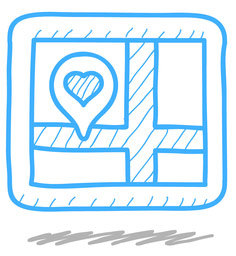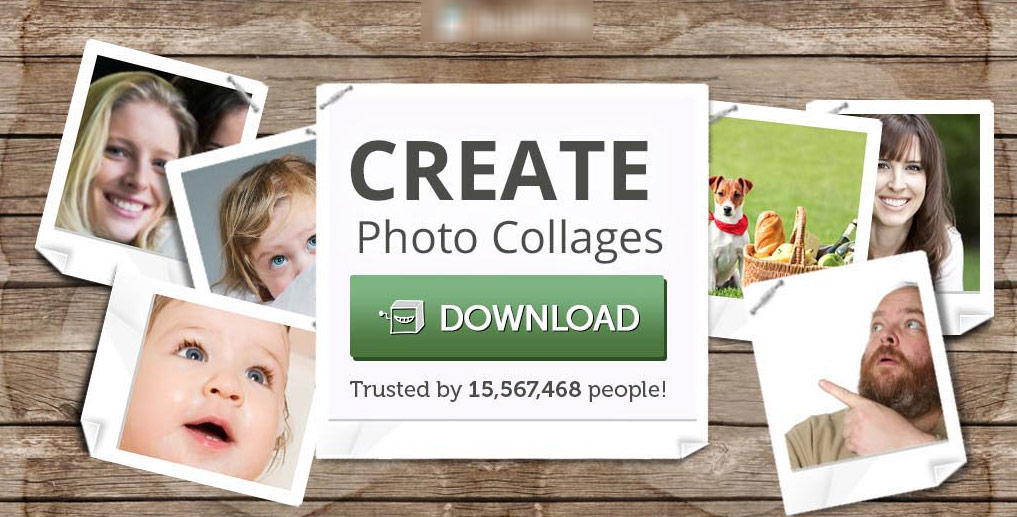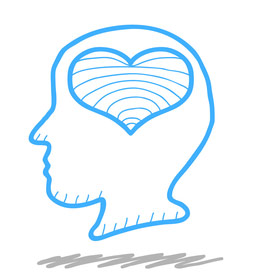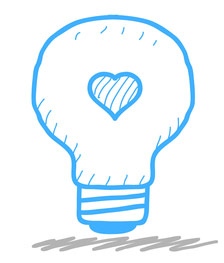Decisions, decisions, decisions! Every day we are faced with a constant series of decisions. Whether it is deciding to eat that piece of cake, or make a career change, the decisions we make shape our lives and who we are. We like to think that all of our decisions are rational and that we are in control, however our unconscious mind, drives how we respond to advertising, brands, products, and in the end determines all of our buying decision. As a result, our landing page design plays an integral role in how our brains make a decision to buy a product or not. The reasons unconscious triggers determine our decisions can be found in the structure of our brain. We can break our mind into three separate parts:
- The outermost, or newest part of the brain – this is the most evolved part of the brain, known as the cortex. It is responsible for logic, learning, language, conscious thought and our personalities.
- The middle brain – this is also known as the limbic system that deals with our moods, memory, and hormones.
- The old brain – this is also known as the R Complex that controls our basic survival functions like flight-or-fight, hunger, breathing, and staying out of danger.
Our decision process can be broken into 4 different stages, and our landing page design can have an impact on all 4:
Step 1: Recognizing a Problem or Unmet Need
 Most decisions start with some sort of a problem where an individual develops a want or need that must be satisfied. Our old brain is driven heavily by emotions that drive our needs identification. The consumer feels that something is missing and they need to have it fulfilled. Marketers address potential customers with a landing page at the time they’re developing these needs and need to trigger specific emotions to influence buying behavior. At times, our minds haven’t yet fully decided on what we need or how we need it and so the landing page design can have a great impact on the end result.
Most decisions start with some sort of a problem where an individual develops a want or need that must be satisfied. Our old brain is driven heavily by emotions that drive our needs identification. The consumer feels that something is missing and they need to have it fulfilled. Marketers address potential customers with a landing page at the time they’re developing these needs and need to trigger specific emotions to influence buying behavior. At times, our minds haven’t yet fully decided on what we need or how we need it and so the landing page design can have a great impact on the end result.
Step 2: Seeking Out A Solution
In the searching phase, we are looking for products or services that can satisfy our needs and wants. Search engines have become the primary tool we use for answers, as it provides an instant set of options to fulfill our needs, but you may also reach out to friends, families, or colleagues for their perspective. This is why testimonials and other trust elements are important on landing pages. Be showing our potential customers that we’re trusted by many others and loved by others we’re fulfilling the important element of security, trust and needs.  Memories and past experiences also play a critical role in the search process. You may have had a life experience in the past that helps you make the correct purchase decision, or you could just know what decision to make just by picking things up over the years and knowing how to solve them. The middle part of the brain plays a critical role in this phase, as it is associated with memory and mood.
Memories and past experiences also play a critical role in the search process. You may have had a life experience in the past that helps you make the correct purchase decision, or you could just know what decision to make just by picking things up over the years and knowing how to solve them. The middle part of the brain plays a critical role in this phase, as it is associated with memory and mood.  Our old brains are also highly influenced by beginnings and endings. Our initial impression becomes the filter for how we perceive what is to follow. As marketers, it is critical to leave a strong first impression, like a compelling story or a big smile. We’ve already established that the first 3 seconds a visitor sees a landing page has the biggest impact on the funnel and conversion rate: What impressions are you leaving with your prospects in the first few seconds?
Our old brains are also highly influenced by beginnings and endings. Our initial impression becomes the filter for how we perceive what is to follow. As marketers, it is critical to leave a strong first impression, like a compelling story or a big smile. We’ve already established that the first 3 seconds a visitor sees a landing page has the biggest impact on the funnel and conversion rate: What impressions are you leaving with your prospects in the first few seconds?
Step 3: Evaluating Alternatives
 After searching to determine what will satisfy our want or needs we begin to seek out the best deal. We may think we base this on price, quality, or other factors that are important to ultimately choose the one that satisfies all of our parameters but in fact our decisions are motivated by our experiences and emotions and so the experience we create on our landing pages is important. Essentially, there are two separate networks within our brain, one that determines risk versus reward, and another that determines how we will ultimately behave. Ralph Adolphs, a professor of psychology at Caltech, explains the distinction by way of a grocery shopping example: “Your valuation network is always providing you with information about what’s rewarding around you — the things you want to buy — but also lots of distracting things like junk food and other items popping into your vision off the shelves.” This is a great example by Adolphs on the important of clean and clutter free landing pages – the more precise you are the less confusion you cause. Less options = Easier decision-making. In evaluating alternatives, our old brain is loos to seek pleasure and avoid pain. In previous posts we discussed loss aversion, the bias that subconsciously makes us focus more on getting hurt (loss) over the need to feel great or fulfill a need (wins). There are many great ways to utilize loss aversion to your advantage on your landing page design from free trials to last minute sales. More detailed examples here.
After searching to determine what will satisfy our want or needs we begin to seek out the best deal. We may think we base this on price, quality, or other factors that are important to ultimately choose the one that satisfies all of our parameters but in fact our decisions are motivated by our experiences and emotions and so the experience we create on our landing pages is important. Essentially, there are two separate networks within our brain, one that determines risk versus reward, and another that determines how we will ultimately behave. Ralph Adolphs, a professor of psychology at Caltech, explains the distinction by way of a grocery shopping example: “Your valuation network is always providing you with information about what’s rewarding around you — the things you want to buy — but also lots of distracting things like junk food and other items popping into your vision off the shelves.” This is a great example by Adolphs on the important of clean and clutter free landing pages – the more precise you are the less confusion you cause. Less options = Easier decision-making. In evaluating alternatives, our old brain is loos to seek pleasure and avoid pain. In previous posts we discussed loss aversion, the bias that subconsciously makes us focus more on getting hurt (loss) over the need to feel great or fulfill a need (wins). There are many great ways to utilize loss aversion to your advantage on your landing page design from free trials to last minute sales. More detailed examples here.
Step 4: Making A Selection
 Our brains appear wired, often subconsciously, to make the best decision with the information we are given. Sensory information is entered and registered in our brains, and like a cerebral courtroom our brain cells are the jury, weighing each piece of evidence to make a judgment. As we narrow down our selection process our cognitive control kicks in from our outermost, or newest, part of the brain. A study at Caltech found that two distinct brain networks undertake our decision-making and behaviors. “Cognitive control and value based decision tasks appear to depend on different brain regions within the prefrontal cortex.” Cognitive control holds the network together. Adolphs goes on to say, “to be able to get to the checkout counter with what you planned, you need to maintain a goal in mind, such as perhaps only buying the salad you needed for dinner. That’s your cognitive control network maintaining an overall goal despite lots of distractions.” This stage of the decision process enhances the importance to remove distractions from our landing pages to make it easier for customers to make their ultimate selection. A landing page with too much information makes it harder on the brain to make a decision:
Our brains appear wired, often subconsciously, to make the best decision with the information we are given. Sensory information is entered and registered in our brains, and like a cerebral courtroom our brain cells are the jury, weighing each piece of evidence to make a judgment. As we narrow down our selection process our cognitive control kicks in from our outermost, or newest, part of the brain. A study at Caltech found that two distinct brain networks undertake our decision-making and behaviors. “Cognitive control and value based decision tasks appear to depend on different brain regions within the prefrontal cortex.” Cognitive control holds the network together. Adolphs goes on to say, “to be able to get to the checkout counter with what you planned, you need to maintain a goal in mind, such as perhaps only buying the salad you needed for dinner. That’s your cognitive control network maintaining an overall goal despite lots of distractions.” This stage of the decision process enhances the importance to remove distractions from our landing pages to make it easier for customers to make their ultimate selection. A landing page with too much information makes it harder on the brain to make a decision:

Little-short cuts, big biases
With all of the decisions we are faced with each day, our brain is forced to sometimes take small shortcuts. Sometimes these shortcuts lead to irrational decisions caused by cognitive biases. Let’s take a look at three types of cognitive biases:
- The Sobering-Up Effect: What do you feel at the start of a new project? Enthusiasm? Energy? Optimism? As the deadline approaches the shine starts to come off a bit. That initial enthusiasm begins to give way to pessimism, cynicism, and even despair. If this has happened to you then you are not alone. What’s worse is the more important an outcome is the stronger the sobering effect. As marketers, our customers can be faced with a sobering effect right at the time of purchase. This is why it is so critical to help our customers over the final hurdle by making the checkout process as easy and intuitive as possible, and highlighting the benefits gained by completing the process. Check out these 30 best practices and tips for checkout optimization.
- The Anchoring Effect: We’ve all heard about the importance of making a great first impression, but this too is a cognitive bias known as the anchoring effect. To highlight how the anchoring effect works, psychologists asked one group if Mahatma Gandhi was older or younger than 9 years old when he died. The other group was asked if he was younger or older than 140. Now obviously he was older than 9 and the oldest know person ever only lived to 122, but the point of the study was to see how the question would impact the participants’ perception of Ghandi’s age. When asked how old Ghandi was when he died the first group guessed 50 and the second group guessed 67. This shows how we tend to use anchors, or reference points in decision making. The anchoring effect has huge implications for pricing and also for negotiations. Steve Jobs knew this very well and used anchoring to sell the iPads.
- The Availability Bias: “It Could Be You” are the words used to promote the UK lottery. What they leave out is “it could be you, but it almost certainly won’t be.” Even though most of us know that the odds are stacked against, lottery tickets are bought so frequently they are virtually a license to print money. All lotteries utilize something called the availability bias. Since lotteries heavily promote the few people who win the jackpots we never hear about the millions who have never won a cent. This leads people to assume they are much more likely to win than they actually are and is known as the availability bias. When information is more obvious, vivid, or easier to recall, it biases the way we assess the probability of that event.
There are many different variables that effect our decisions in life, especially our purchasing habits. It’s hard to take most of them into account while designing your landing page but by simply understanding that our landing page design has an effect on our customers decisions we are sure to create a better and more easier journey for our customers.
How to Use Psychology in Landing Page Design 4.75/5 (95.00%) 4 votes
Related Posts


How to Use Psychology in Landing Page Design
Decisions, decisions, decisions! Every day we are faced with a constant series of decisions. Whether it is deciding to eat that piece of cake, or make a career change, the decisions we make shape our lives and who we are. We like to think that all of our decisions are rational and that we are in control, however our unconscious mind, drives how we respond to advertising, brands, products, and in the end determines all of our buying decision. As a result, our landing page design plays an integral role in how our brains make a decision to buy a product or not. The reasons unconscious triggers determine our decisions can be found in the structure of our brain. We can break our mind into three separate parts:
Our decision process can be broken into 4 different stages, and our landing page design can have an impact on all 4:
Step 1: Recognizing a Problem or Unmet Need
Step 2: Seeking Out A Solution
In the searching phase, we are looking for products or services that can satisfy our needs and wants. Search engines have become the primary tool we use for answers, as it provides an instant set of options to fulfill our needs, but you may also reach out to friends, families, or colleagues for their perspective. This is why testimonials and other trust elements are important on landing pages. Be showing our potential customers that we’re trusted by many others and loved by others we’re fulfilling the important element of security, trust and needs. Memories and past experiences also play a critical role in the search process. You may have had a life experience in the past that helps you make the correct purchase decision, or you could just know what decision to make just by picking things up over the years and knowing how to solve them. The middle part of the brain plays a critical role in this phase, as it is associated with memory and mood.
Memories and past experiences also play a critical role in the search process. You may have had a life experience in the past that helps you make the correct purchase decision, or you could just know what decision to make just by picking things up over the years and knowing how to solve them. The middle part of the brain plays a critical role in this phase, as it is associated with memory and mood.  Our old brains are also highly influenced by beginnings and endings. Our initial impression becomes the filter for how we perceive what is to follow. As marketers, it is critical to leave a strong first impression, like a compelling story or a big smile. We’ve already established that the first 3 seconds a visitor sees a landing page has the biggest impact on the funnel and conversion rate: What impressions are you leaving with your prospects in the first few seconds?
Our old brains are also highly influenced by beginnings and endings. Our initial impression becomes the filter for how we perceive what is to follow. As marketers, it is critical to leave a strong first impression, like a compelling story or a big smile. We’ve already established that the first 3 seconds a visitor sees a landing page has the biggest impact on the funnel and conversion rate: What impressions are you leaving with your prospects in the first few seconds?
Step 3: Evaluating Alternatives
Step 4: Making A Selection
Little-short cuts, big biases
With all of the decisions we are faced with each day, our brain is forced to sometimes take small shortcuts. Sometimes these shortcuts lead to irrational decisions caused by cognitive biases. Let’s take a look at three types of cognitive biases:
There are many different variables that effect our decisions in life, especially our purchasing habits. It’s hard to take most of them into account while designing your landing page but by simply understanding that our landing page design has an effect on our customers decisions we are sure to create a better and more easier journey for our customers.
Related Posts
Tags: